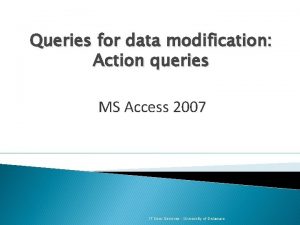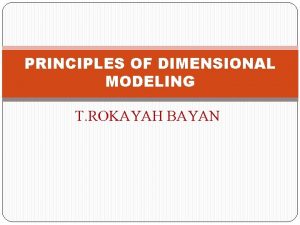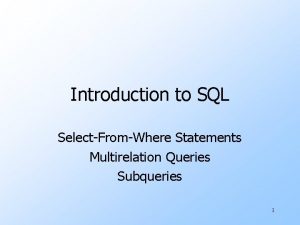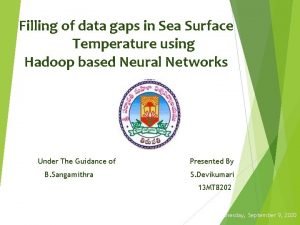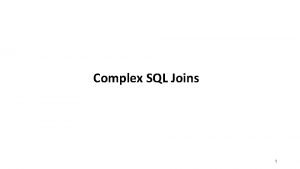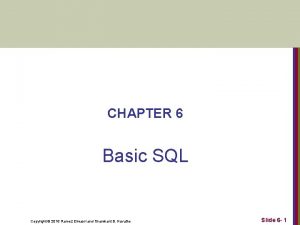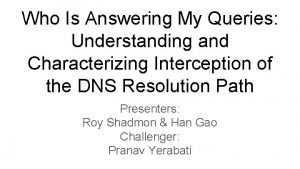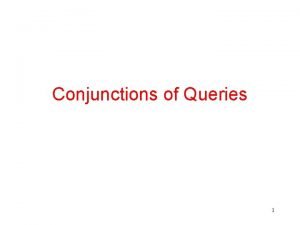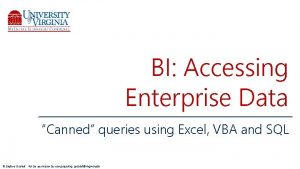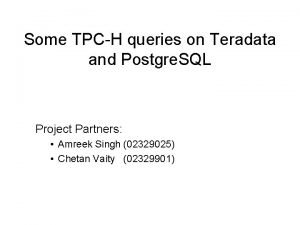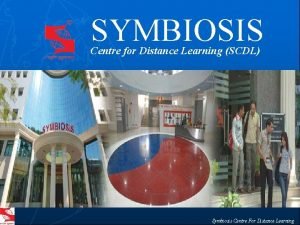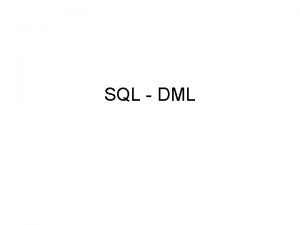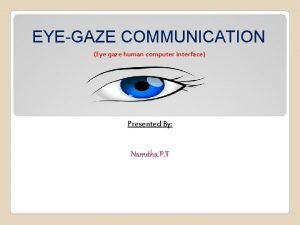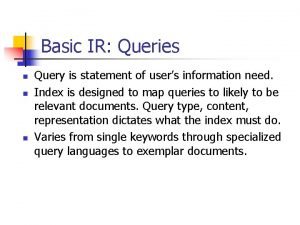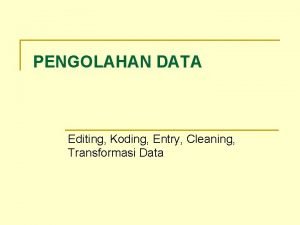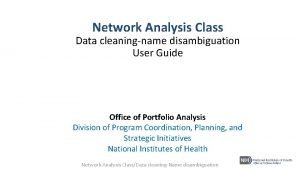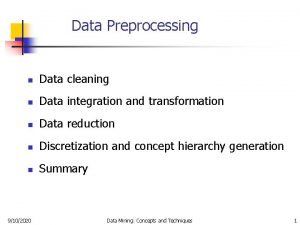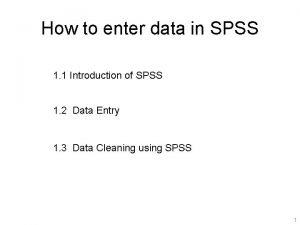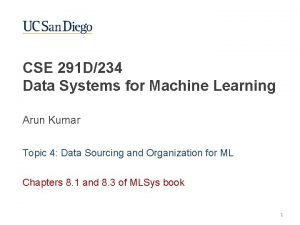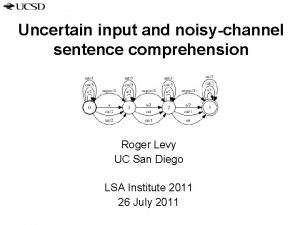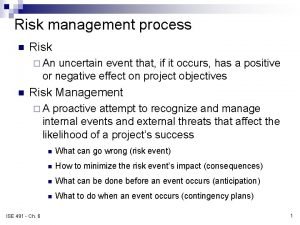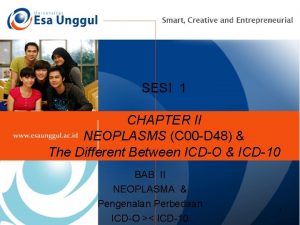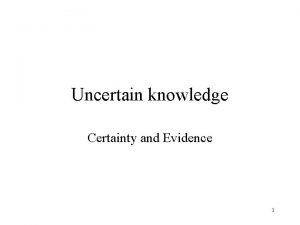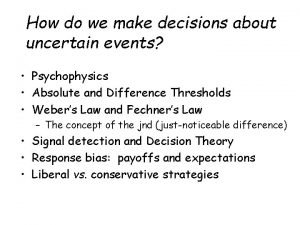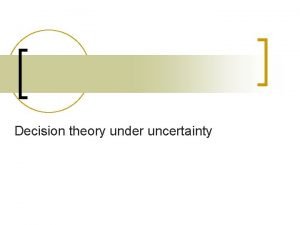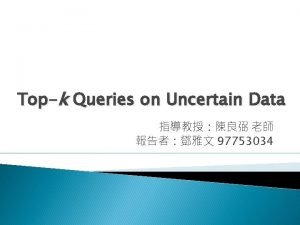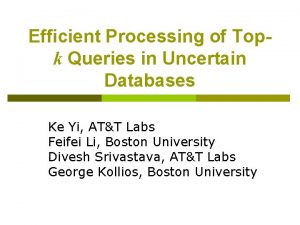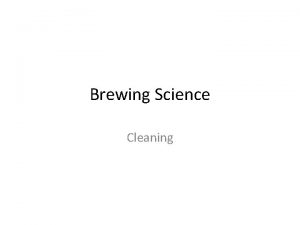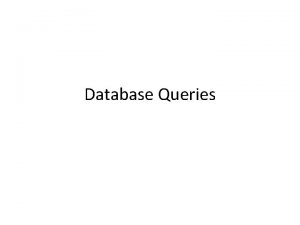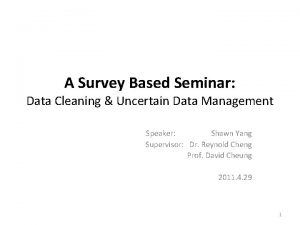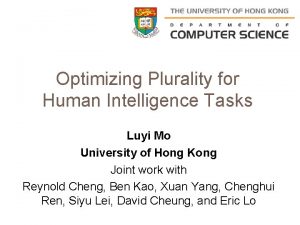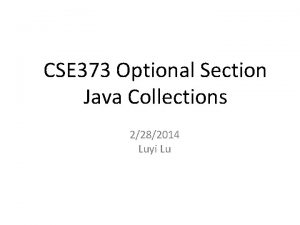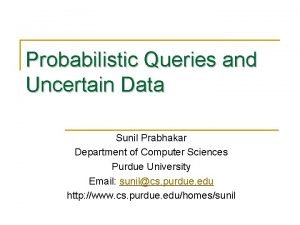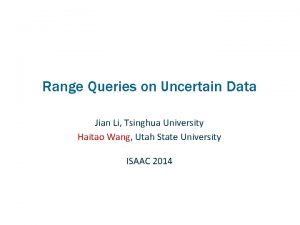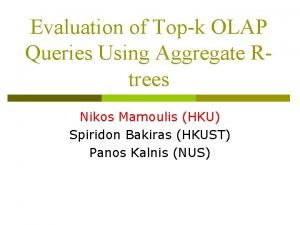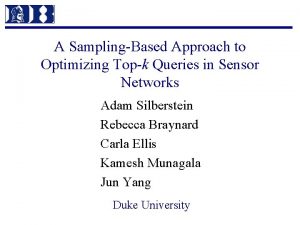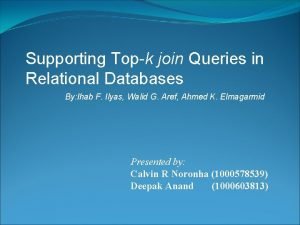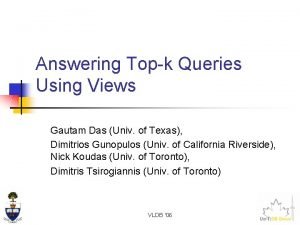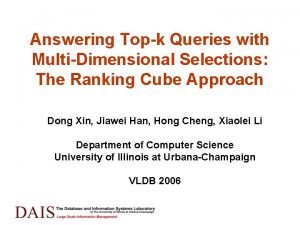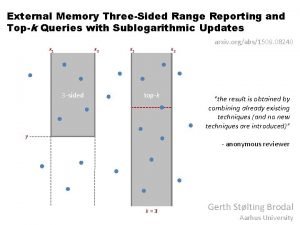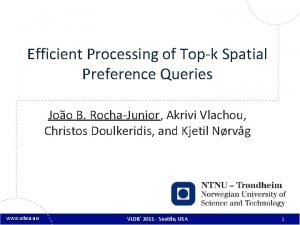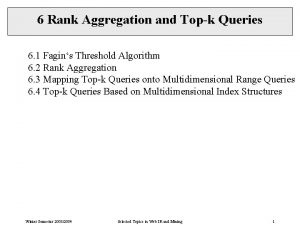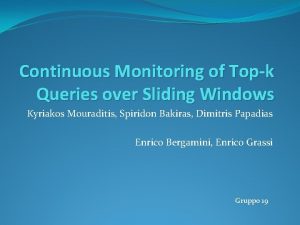CLEANING UNCERTAIN DATA FOR TOPK QUERIES Luyi Mo






![Related Work: Cleaning Uncertain DB 7 Cleaning for range/max query [Cheng VLDB’ 08] Explore Related Work: Cleaning Uncertain DB 7 Cleaning for range/max query [Cheng VLDB’ 08] Explore](https://slidetodoc.com/presentation_image_h2/7b2eb4124cdf5432dd88a7e38737bc0b/image-7.jpg)
![Related Work: Top-k Queries 8 Various query semantics U-Topk, U-k. Ranks [Soliman 07] PT-k Related Work: Top-k Queries 8 Various query semantics U-Topk, U-k. Ranks [Soliman 07] PT-k](https://slidetodoc.com/presentation_image_h2/7b2eb4124cdf5432dd88a7e38737bc0b/image-8.jpg)




![13 The Possible World Semantics Quality (PWS-Quality) [Cheng VLDB’ 08] PWS-quality = -2. 55 13 The Possible World Semantics Quality (PWS-Quality) [Cheng VLDB’ 08] PWS-quality = -2. 55](https://slidetodoc.com/presentation_image_h2/7b2eb4124cdf5432dd88a7e38737bc0b/image-13.jpg)

![TP: Computation based on Rank Prob. 15 PSR [Bernecker, TKDE 10] An efficient solution TP: Computation based on Rank Prob. 15 PSR [Bernecker, TKDE 10] An efficient solution](https://slidetodoc.com/presentation_image_h2/7b2eb4124cdf5432dd88a7e38737bc0b/image-15.jpg)






















![Reference 38 [Soliman 07] M. A. Soliman, I. F. Ilyas, and K. C. -C. Reference 38 [Soliman 07] M. A. Soliman, I. F. Ilyas, and K. C. -C.](https://slidetodoc.com/presentation_image_h2/7b2eb4124cdf5432dd88a7e38737bc0b/image-38.jpg)
![Related Works 39 Data Models Independent tuple/attribute uncertainty [Barbara 92] x-tuple (ULDB) [Benjelloun 06] Related Works 39 Data Models Independent tuple/attribute uncertainty [Barbara 92] x-tuple (ULDB) [Benjelloun 06]](https://slidetodoc.com/presentation_image_h2/7b2eb4124cdf5432dd88a7e38737bc0b/image-39.jpg)




![44 The Possible World Semantics Quality (PWS-Quality) [Cheng 08] Expensive to compute! PWS-quality = 44 The Possible World Semantics Quality (PWS-Quality) [Cheng 08] Expensive to compute! PWS-quality =](https://slidetodoc.com/presentation_image_h2/7b2eb4124cdf5432dd88a7e38737bc0b/image-44.jpg)










- Slides: 54

CLEANING UNCERTAIN DATA FOR TOP-K QUERIES Luyi Mo, Reynold Cheng, Xiang Li, David Cheung, Xuan Yang The University of Hong Kong {lymo, ckcheng, xli, dcheung, xyang 2}@cs. hku. hk

Outline 2 Introduction Quality Metric for Top-k Queries Definition Efficient computation Results Cleaning for Top-k Queries Definition Solutions Results Conclusion

Data Uncertainty 3 Inherent in various applications Location-based services (e. g. , using GPS, RFID) Natural habitat monitoring with sensor networks Data integration

Uncertain Databases 4 Model data uncertainty e. g. , tuple t has existential probability e Enable probabilistic queries Produce ambiguous query answers e. g. , tuple t has probability p for satisfying a query

“Cleaning” of Uncertain Data 5 Query $$ Query Uncertain DB LESS Uncertain DB Ambiguous result LESS ambiguous result Fail? A quality metric to quantify the ambiguity of query results

Example: Sensor Probing 6 In natural habitat monitoring, sensors are used to track external environment The system probes from sensors to refresh stale data Probes may fail due to network reliability problem Battery and network resources should be optimized
![Related Work Cleaning Uncertain DB 7 Cleaning for rangemax query Cheng VLDB 08 Explore Related Work: Cleaning Uncertain DB 7 Cleaning for range/max query [Cheng VLDB’ 08] Explore](https://slidetodoc.com/presentation_image_h2/7b2eb4124cdf5432dd88a7e38737bc0b/image-7.jpg)
Related Work: Cleaning Uncertain DB 7 Cleaning for range/max query [Cheng VLDB’ 08] Explore and exploit to disambiguating database [Cheng VLDB’ 10] Probing from stream source [Chen SSDBM’ 08] Model different factors of cleaning operations Consider no probabilistic model or query Range query Improve integration quality by user feedback [Keulen VLDBJ’ 09] Analyze sensitivity of answer to input data [Kanagal SIGMOD’ 11] We consider uncertain data cleaning for probabilistic top-k queries
![Related Work Topk Queries 8 Various query semantics UTopk Uk Ranks Soliman 07 PTk Related Work: Top-k Queries 8 Various query semantics U-Topk, U-k. Ranks [Soliman 07] PT-k](https://slidetodoc.com/presentation_image_h2/7b2eb4124cdf5432dd88a7e38737bc0b/image-8.jpg)
Related Work: Top-k Queries 8 Various query semantics U-Topk, U-k. Ranks [Soliman 07] PT-k [Hua 08] Global-topk [Zhang 08] Expected Rank [Cormode 09] …… Efficient evaluation [Bernecker 10, Yi 08, Li 09, Lian 08] Cleaning for top-k queries is challenging

Our Contributions 9 Measure quality of query answer for three top-k queries Adopt PWS-quality Develop efficient computation for quality score Clean uncertain data for top-k queries Model cost, budget, cleaning successfulness Propose cleaning algorithms to attain the highest expected improvement in PWS-quality

Probabilistic Data Model (x-tuple model) 10 Tuple (ti) Querying Attribute (vi) x-tuple Sensor ID S 1 x-tuple S 2 S 3 S 4 Key Temp. (o. C) Prob. t 0 21 0. 6 t 1 32 0. 4 t 2 30 0. 7 t 3 22 0. 3 t 4 25 0. 4 t 5 27 0. 6 t 6 26 1 Existential probability (ei) i-th tuple

Probabilistic Top-k Queries 11 U-k. Ranks v No work about how to measure the quality of query answers (t 2, t 5) PT-k (prob. threshold top-k) Threshold=0. 4 (t 1, t 2, t 5) Global-topk (t 2, t 5) Rank Probability Information (k=2) Prob. t 0 t 1 t 2 t 3 t 4 t 5 t 6 Rank-1 0 0. 42 0 0 0. 108 0. 072 Rank-2 0 0 0. 28 0 0. 072 0. 324 Top-2 0 0. 4 0. 7 0 0. 072 0. 432 0. 396

Probabilistic Top-k Queries 12 Possible World Results 0. 28 Rank Probability Information Possible World Semantics
![13 The Possible World Semantics Quality PWSQuality Cheng VLDB 08 PWSquality 2 55 13 The Possible World Semantics Quality (PWS-Quality) [Cheng VLDB’ 08] PWS-quality = -2. 55](https://slidetodoc.com/presentation_image_h2/7b2eb4124cdf5432dd88a7e38737bc0b/image-13.jpg)
13 The Possible World Semantics Quality (PWS-Quality) [Cheng VLDB’ 08] PWS-quality = -2. 55 Entropy Expensive to compute!

PWR: Derives PW-Results Directly 14 No. of distinct pw-results is bounded by n^k (n is the database size) Advantage: Reduce complexity Not efficient enough if number of PW-results is large!
![TP Computation based on Rank Prob 15 PSR Bernecker TKDE 10 An efficient solution TP: Computation based on Rank Prob. 15 PSR [Bernecker, TKDE 10] An efficient solution](https://slidetodoc.com/presentation_image_h2/7b2eb4124cdf5432dd88a7e38737bc0b/image-15.jpg)
TP: Computation based on Rank Prob. 15 PSR [Bernecker, TKDE 10] An efficient solution framework for top-k query evaluation

TP: Tuple Form of PWS-Quality 16 PWS-quality can be expressed by the existential probabilities and top-k probabilities of tuples PWS-quality where is some function of existential probabilities of tuples in D

TP: Sharing of Computation Effort 17 Steps of TP: O(nk) for PSR [Bernecker, TKDE 10] to compute all O(n) for an incremental method to compute all Rank prob. information can be shared by query and quality evaluation! Rank Probability Information

Experiment Setup 18 Size of DB 5 K x-tuples, 50 K tuples (synthetic) 4, 999 x-tuples, 10, 037 tuples (Netflix movie ratings) Prob. distributions Gaussian (variance = 100) Mean of each x-tuple, uniform in [0, 10000] Top-k Queries k = 15 Threshold for PT-k = 0. 1 ØBy default, results are shown on synthetic data.

Quality Score vs. k 19

Evaluation Time 20

TP: Effect of Sharing (1) 21 48% Query+Quality Time vs. k Top-k query: PT-k; Non-sharing: rank probability information is recomputed when computing the quality score

TP: Effect of Sharing (2) 22 6. 3% PT-k Time vs. Quality Time (with sharing)

Results on Real Data 23 Quality Score vs. k PT-k Time vs. Quality Time (with sharing) Similar to results on synthetic data

Outline 24 Introduction Quality Metric for Top-k Queries Definition Efficient computation Results Cleaning for Top-k Queries Definition Solutions Results Conclusion

Example 25 Cost Cleaning may require resources Sensor ID $3 $9 $11 $1 S 2 S 3 S 4 Key Temp. Prob. Sc(o. C) prob. t 0 21 0. 6 t 1 32 0. 4 t 2 30 0. 7 t 3 22 0. 3 t 4 25 0. 4 t 5 27 0. 6 t 6 26 1 Sensor Readings Limited budget A budget (e. g. , $12) restricts the no. of cleaning actions 0. 8 0. 3 0. 7 0. 6 Successfulness Cleaning action has a successful cleaning probability (sc-prob) Objective Optimize the quality improvement after cleaning Cleaning plan Which x-tuples should be cleaned? How many times the cleaning actions should be performed?

Cleaning Model 26 D: uncertain database, a set of x-tuples τl : the l-th x-tuple cl : cost of cleaning τl once pl : successful probability of cleaning actions on τl B : cleaning budget (X, M) : cleaning plan to clean τl for Ml times, where τl is in X

An Optimization Problem 27 I(X, M) : expected quality improvement of (X, M) Budget constraint Challenges: v Computation of I(X, M) is nontrivial v number of possible cleaning plans may be exponential

Expected Quality Improvement 28 Given a cleaning plan Sensor ID S 1 S 2 Clean S 3 once Scprob. 0. 8 0. 3 S 3 0. 7 S 4 0. 6 Key Temp. Prob. (o. C) Top-k Prob. t 0 21 0. 6 0 t 1 32 0. 4 t 2 30 0. 7 t 3 22 0. 3 0 t 4 25 0. 4 0. 072 t 5 27 0. 6 1 0. 432 0. 72 t 6 26 1 0. 396 0. 18 PWS-quality = -1. 85 PWS-quality = -2. 55 Expected quality of cleaning x-tuple S 3: = 0. 7 * (0. 4 * -1. 85 + 0. 6 * -1. 85) + (1 -0. 7) * -2. 55 = -2. 06 Cleaning on S 3 is successful Cleaning on S 3 fails No. of possible cleaned results is exponential!

Efficient Expected Quality Improvement Evaluation 29 Given a cleaning plan (X, M) and the tuple form of PWS-quality, the expected quality improvement can be computed in linear time of |X|

Cleaning Algorithms 30 Optimal solution: Variant of knapsack problem DP (dynamic programming) Heuristics: Rand. U (x-tuples have equal prob. to clean) Rand. P (x-tuples with higher top-k prob. also have higher prob. to clean) Greedy (select x-tuples with largest marginal expect quality improvement to clean)

Experiment Setup 31 Size of DB 5 K x-tuples, 50 K tuples (synthetic) 4, 999 x-tuples, 10, 037 tuples (Netflix movie ratings) Prob. distributions Gaussian (variance = 100) Top-k Queries k = 15 Threshold for PT-k = 0. 1 Cleaning cost Uniform in [1, 10] Sc-probability Uniform in [0, 1] Resource budget 100 ØResults are shown on synthetic data.

Effectiveness of Cleaning Algorithms I(X, M) 32 Budget Improvement vs. Budget

Effect of Avg. sc-probability I(X, M) 33

Efficiency on Budget 34 10000 x Budget

Efficiency on k 35 100 x

Conclusion 36 Efficient computation of PWS-quality for probabilistic top-k query Cleaning probabilistic database under limited budget Model cleaning operations Develop optimal and efficient cleaning algorithms for top-k queries Future work Study other probabilistic data model Support other top-k queries, skyline queries, etc.

37 Thank you! Contact Info: Luyi Mo University of Hong Kong lymo@cs. hku. hk http: //www. cs. hku. hk/~lymo
![Reference 38 Soliman 07 M A Soliman I F Ilyas and K C C Reference 38 [Soliman 07] M. A. Soliman, I. F. Ilyas, and K. C. -C.](https://slidetodoc.com/presentation_image_h2/7b2eb4124cdf5432dd88a7e38737bc0b/image-38.jpg)
Reference 38 [Soliman 07] M. A. Soliman, I. F. Ilyas, and K. C. -C. Chang, “Top-k query processing in uncertain databases, ” in ICDE, 2007 [Hua 08] M. Hua, J. Pei, W. Zhang, and X. Lin, “Ranking queries on uncertain data: a probabilistic threshold approach, ” in SIGMOD, 2008 [Yi 08] K. Yi, F. Li, G. Kollios, and D. Srivastava, “Efficient processing of top-k queries in uncertain databases with x-relations, ” TKDE, 2008 [Zhang 08] X. Zhang and J. Chomicki, “On the semantics and evaluation of top-k queries in probabilistic databases, ” in ICDE Workshop, 2008 [Cormode 09] G. Cormode, F. Li, and K. Yi, “Semantics of ranking queries for probabilistic data and expected ranks, ” in ICDE, 2009 [Bernecker 10] T. Bernecker, H. Kriegel, N. Mamoulis, M. Renz, and A. Zuefle, “Scalable probabilistic similarity ranking in uncertain databases, ” TKDE, 2010 [Cheng 08] R. Cheng, J. Chen, and X. Xie, “Cleaning uncertain data with quality guarantees, ” 2008 [Li 09] J. Li, B. Saha, and A. Deshpande, “A unified approach to ranking in probabilistic databases, ” 2009 [Lian 08] X. Lian and L. Chen, “Probabilistic ranked queries in uncertain databases, ” in EDBT 08 [Keulen 09] M. van Keulen and A. de Keijzer, “Qualitative effects of knowledge rules and user feedback in probabilistic data integration, ” The VLDB Journal, 2009 [Kanagal 11] B. Kanagal, J. Li, and A. Deshpande, “Sensitivity analysis and explanations for robust query evaluation in probabilistic databases, ” in SIGMOD, 2011 [Cheng 10] R. Cheng, E. Lo, X. S. Yang, M. -H. Luk, X. Li, and X. Xie, “Explore or exploit? effective strategies for disambiguating large databases, ” 2010 [Chen 08] J. Chen and R. Cheng, “Quality-aware probing of uncertain data with resource constraints, ” in SSDBM, 2008 [Cheng 04] R. Cheng, Y. Xia, S. Prabhakar, R. Shah, and J. S. Vitter. Efficient indexing methods for probabilistic threshold queries over uncertain data. In VLDB, 2004. [Tao 05]Y. Tao, R. Cheng, X. Xiao, W. K. Ngai, B. Kao, and S. Prabhakar. Indexing multi-dimensional uncertain data with arbitrary probability density functions. In VLDB, 2005.
![Related Works 39 Data Models Independent tupleattribute uncertainty Barbara 92 xtuple ULDB Benjelloun 06 Related Works 39 Data Models Independent tuple/attribute uncertainty [Barbara 92] x-tuple (ULDB) [Benjelloun 06]](https://slidetodoc.com/presentation_image_h2/7b2eb4124cdf5432dd88a7e38737bc0b/image-39.jpg)
Related Works 39 Data Models Independent tuple/attribute uncertainty [Barbara 92] x-tuple (ULDB) [Benjelloun 06] Graphical model [Sen 07] Categorical uncertain data [Singh 07] World-set descriptor sets [Antova 08] Query Evaluation Probabilistic Query Classification [Cheng 03] Efficiency of query evaluation [Dalvi 04] Range queries [Cheng 04, Tao 05, Cheng 07] MIN/MAX [Cheng 03, Deshpande 04] Top-k query evaluation [Soliman 07, Re 07, Yi 08, Bernecker 10, Li 09, Lian 08]

Related Works 40 Quality metric for uncertain DB Result probability > threshold [Cheng 04, Desphande 04] PWS-quality (Possible World Semantics Quality) [Cheng 08] Number of alternatives (non-prob. DB) [Cheng 10]

Example: PT-k 41 Sensor ID S 1 S 2 S 3 S 4 Key Temp. (o. C) Prob. t 0 21 0. 6 t 1 32 0. 4 t 2 30 0. 7 t 3 22 0. 3 t 4 25 0. 4 t 5 27 0. 6 t 6 26 1 Result <S 1, 32> <S 2, 30> <S 3, 27> Prob. 0. 4 0. 7 0. 432 Return sensors which have at least 40% to yield 2 highest temperature PT-k with k = 2, T = 0. 4 PW-Results

Example: cleaning objective 42 Sensor ID S 1 S 2 S 3 S 4 Key Temp. (o. C) Prob. t 0 21 0. 6 t 1 32 0. 4 t 2 30 0. 7 t 3 22 0. 3 t 4 25 0. 4 1 t 5 27 0. 6 t 6 26 1 PWS-quality = -2. 55 Return sensors which yield 2 highest temperature The database may be cleaned by probing the sensors to attain its latest reading Suppose we clean sensor S 3. PWS-quality=-1. 85

Example: PT-k 43 PWS-quality = -2. 55 Result <S 1, 32> <S 2, 30> <S 3, 27> Prob. 0. 4 0. 7 0. 432 Result <S 1, 32> <S 2, 30> <S 3, 27> Prob. 0. 4 0. 72 PWS-quality=-1. 85
![44 The Possible World Semantics Quality PWSQuality Cheng 08 Expensive to compute PWSquality 44 The Possible World Semantics Quality (PWS-Quality) [Cheng 08] Expensive to compute! PWS-quality =](https://slidetodoc.com/presentation_image_h2/7b2eb4124cdf5432dd88a7e38737bc0b/image-44.jpg)
44 The Possible World Semantics Quality (PWS-Quality) [Cheng 08] Expensive to compute! PWS-quality = -2. 55 PWS-quality=-1. 85 If some uncertainty of the DB is removed Entropy

PWR: PW-Results Derivation and 45 Probability Computation Derivation O(n^k) Enumerate all combinations with exactly k tuples When tuples are pre-sorted pruning techniques Probability Computation τ O(n) If the pw-result is given, tuples exist in pw-result tuples with high score do not exist in pw-result

TP: Tuple Form of PWS-Quality 46 PWS-quality can be expressed by the existential probabilities and top-k probabilities of tuples PWS-quality where is some function of existential probabilities of tuples in the same x-tuple with and ranked higher

TP: Example 47 0. 4 0. 7 t 1 t 2 0. 432 0. 396 0. 072 0 t 5 -2. 43 -1. 26 -1. 62 t 6 t 4 0 0 t 3 0 t 0 early stop Quality score = -2. 55

Results on Real Data 48 Quality Score vs. k

Results on Real Data 49 Quality and Query Evaluation Time with Sharing

Results on Real Data 50

Comparison with PW 51

Effect of sc-pdf (Cleaning Algorithms) 52

53 Effect of Avg. sc-probability (Cleaning Algorithms)

Efficiency on k (Cleaning Algorithms) 54
 Data cleaning problems and current approaches
Data cleaning problems and current approaches Data quality and data cleaning an overview
Data quality and data cleaning an overview Data quality and data cleaning an overview
Data quality and data cleaning an overview Using subqueries to solve queries
Using subqueries to solve queries Standing query
Standing query Action queries in access
Action queries in access Any queries slide
Any queries slide Multirelation queries
Multirelation queries Wildcard query in information retrieval
Wildcard query in information retrieval Thank you any queries
Thank you any queries Complex sql join queries
Complex sql join queries Basic retrieval queries in sql
Basic retrieval queries in sql Hotel.hotelno=room.hotelno(hotel room)
Hotel.hotelno=room.hotelno(hotel room) Sql queries for insert update and delete
Sql queries for insert update and delete Answering my queries
Answering my queries Wideworldimporters
Wideworldimporters Sql queries for banking database
Sql queries for banking database Conjunctive queries
Conjunctive queries Stefano grazioli
Stefano grazioli Join ordering in fragment queries
Join ordering in fragment queries Teradata ordbms
Teradata ordbms For any queries
For any queries Scdl service request form
Scdl service request form Data manipulation language in sql
Data manipulation language in sql Suggestions and queries
Suggestions and queries Jafar shah
Jafar shah J query
J query Eyegaze
Eyegaze Rrc completion query
Rrc completion query Texas railroad commission online queries
Texas railroad commission online queries Codeapillar troubleshooting
Codeapillar troubleshooting Basic ir
Basic ir Editing coding entry cleaning
Editing coding entry cleaning Potter's tool is data cleaning tool
Potter's tool is data cleaning tool Data cleaning in stata
Data cleaning in stata Disambiguation data cleaning
Disambiguation data cleaning Data integration in data preprocessing
Data integration in data preprocessing Entering data in spss
Entering data in spss Data cleaning lesson
Data cleaning lesson Transfer learning ai
Transfer learning ai What are significant figures
What are significant figures Levy in a sentence
Levy in a sentence Uncertain agreements are
Uncertain agreements are Uncertain event
Uncertain event Kode icd 10 oat
Kode icd 10 oat Representing knowledge in an uncertain domain
Representing knowledge in an uncertain domain Uncertain events
Uncertain events Indifference curve risk averse
Indifference curve risk averse Fspos
Fspos Novell typiska drag
Novell typiska drag Nationell inriktning för artificiell intelligens
Nationell inriktning för artificiell intelligens Ekologiskt fotavtryck
Ekologiskt fotavtryck Shingelfrisyren
Shingelfrisyren En lathund för arbete med kontinuitetshantering
En lathund för arbete med kontinuitetshantering Underlag för särskild löneskatt på pensionskostnader
Underlag för särskild löneskatt på pensionskostnader





